| Sunday, May 4, 2003 |  |
|
|
|
GreenBiz via Synergic Earth News:A Swedish firm has invented a new type of material that is half chalk, half plastic. The mixture makes lightweight packaging with an extra twist: When burned, it neutralizes the acid fumes generated by waste incinerators.
"It’s beautiful", said Per Gustafsson, managing director of Ecolean. The firm’s chalk packaging, developed from scratch in 1996, weighs on average half as much as the paper/plastic mix used in milk and juice cartons. Better still, the chalk -- a natural mineral -- can neutralize acidic soil or the fumes from incinerators when burned as waste.
[ Science | 2003-05-04 23:39 | 0 comments | PermaLink ]
|
|
|
|
 Synergetic Earth News mentions this article about a new mathematical formula invented by a Belgian biologist, which apparently can generate a surprising range of natural shapes. Synergetic Earth News mentions this article about a new mathematical formula invented by a Belgian biologist, which apparently can generate a surprising range of natural shapes.One simple equation can generate a vast diversity of natural shapes, a Belgian biologist has discovered. The Superformula, as its creator Johan Gielis has christened it, produces everything from simple triangles and pentagons, to stars, spirals and petals. ... The Superformula is a modified version of the equation for a circle1. Changing one term in the formula varies the proportions of the shape - moving from a round circle to a long and skinny ellipse. Changing another varies the axes of symmetry - shifting from a circle to triangle, square, pentagon and so on. Varying both proportion and symmetry together produces shapes with any number of sides, regular and irregular. It can also produce three-dimensional structures, and non-biological shapes such as snowflakes and crystals. "It's a new way of describing nature," says Gielis. Now, where's the damn formula? Wolfram has a discussion of it here. Not that I really understand it. And it seems that Gielis has formed a company based on his formula.
[ Science | 2003-05-04 23:05 | | PermaLink ] More >
|
|
| Saturday, April 26, 2003 |  |
|
|
|
This article in The Chronicle of Higher Education talks about researchers who believe they have a mathematical model of marriage. It is not quite as crazy as it sounds. A group of researchers at Seattle's Family Research Laboratory, also known as the Love Lab, have over 24 years recorded thousands of conversations between couples, and have discovered certain patterns. So well that they have a 90% accuracy in predicting which ones will divorce. The key point they find in a successful relationship is the ability of the participants to influence each other emotionally, in both positive and negative directions. It is not how much they yell at each other, but it is how flexible they are. If they don't respond to each other's emotions, or only do it in one direction, it will probably fail. So, observers can sit and note down the emotions of the two people who are having a conversation, and can figure out how well it is going based on how well they track with each other. That's kind of cute. Anybody trained in NLP would have noticed the same things right away, and would know what to do about it. But I guess it is good for more mainstream psychology to develop a scientific basis for understanding that relationships work better if people are in rapport with each other.
[ Science | 2003-04-26 23:47 | 0 comments | PermaLink ]
|
|
| Monday, April 21, 2003 |  |
|
|
|
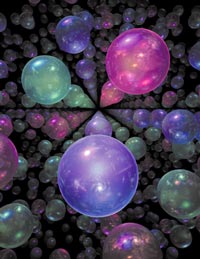 Paul Hughes posts an article by Max Tegmark about several different possible models for the multiverse, involving various scenarios of parallel realities in one form or another. Fascinating reading. Paul Hughes posts an article by Max Tegmark about several different possible models for the multiverse, involving various scenarios of parallel realities in one form or another. Fascinating reading."So should you believe in parallel universes? The principal arguments against them are that they are wasteful and that they are weird. The first argument is that multiverse theories are vulnerable to Occam's razor because they postulate the existence of other worlds that we can never observe. Why should nature be so wasteful and indulge in such opulence as an infinity of different worlds? Yet this argument can be turned around to argue for a multiverse. What precisely would nature be wasting? Certainly not space, mass or atoms--the uncontroversial Level I multiverse already contains an infinite amount of all three, so who cares if nature wastes some more? The real issue here is the apparent reduction in simplicity. A skeptic worries about all the information necessary to specify all those unseen worlds.
But an entire ensemble is often much simpler than one of its members. This principle can be stated more formally using the notion of algorithmic information content. The algorithmic information content in a number is, roughly speaking, the length of the shortest computer program that will produce that number as output. For example, consider the set of all integers. Which is simpler, the whole set or just one number? Naively, you might think that a single number is simpler, but the entire set can be generated by quite a trivial computer program, whereas a single number can be hugely long. Therefore, the whole set is actually simpler. [...]
A common feature of all four multiverse levels is that the simplest and arguably most elegant theory involves parallel universes by default. To deny the existence of those universes, one needs to complicate the theory by adding experimentally unsupported processes and ad hoc postulates: finite space, wave function collapse and ontological asymmetry. Our judgment therefore comes down to which we find more wasteful and inelegant: many worlds or many words. Perhaps we will gradually get used to the weird ways of our cosmos and find its strangeness to be part of its charm. Heheh, that's the cool part. Somebody who proposes anything other than this wonderful infinite unified multiverse will have some serious explaining to do, as to why things would be only that one particular way, rather than ALL ways. I think I'm going to chuckle the rest of the day.
[ Science | 2003-04-21 23:25 | | PermaLink ] More >
|
|
| Monday, April 14, 2003 |  |
|
|
|
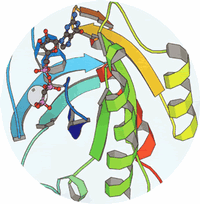 Greg Bear is one of my very favorite science fiction writers. He also has a good grasp of the science part. Recently he's been looking at evolution. FuturePositive has an article The New Biology he wrote recently. Greg Bear is one of my very favorite science fiction writers. He also has a good grasp of the science part. Recently he's been looking at evolution. FuturePositive has an article The New Biology he wrote recently."The unfortunate aspect of the rancorous debate on evolution in the last seventy or more years has been the fossilization of hypotheses. One side says "God and God only," the other says, "Random mutations and natural selection and nothing more." Both are likely wrong. A third variety of "intelligent design" has long been awaiting our attention. Many evolutionary biologists have built their careers on foundations that are erroding rapidly. Specifically that biology and evolution can be reduced to simple mechanistic behaviors, and random stumbling around. Now extraordinary things are being discovered, such as DNA rearranging itself in ways that are nothing like random. And DNA being exchanged in other ways than sexual reproduction. Bear puts forward the hypothesis that computational DNA communicates in various ways, through pheromones, viruses and sexuality; incorporating, selecting and editing genes, as part of a species-wide neural network, solving problems in much vaster scales than science previously anticipated. Regardless of what exactly it is found to be, something big is being discovered. "Some refer to this burgeoning new view as "systems biology." For many conservatives in biology, the changes are heartbreaking, even infuriating. But the evidence has been mounting for decades, and clear signs of the necessity for radical change has been evident for over fifty years. Arthur Koestler fought reductionism in psychology and biology from the 1950s to his death.
We're facing a true paradigm shift. Is that surprising? Did anyone actually believe we had all the answers to something as marvelous and complex as life and evolution?
That organisms exchange genes through other than sexual means is now irrefutable for metazoans as well as microbes. Retroviruses, and now perhaps bacteria, may well serve as vectors for such exchanges. Commensal bacteria in our intestines commonly interact with our tissues. Surprisingly, there appear to be mechanisms in most organisms for evaluating and either destroying or utilizing RNA from outside sources, including retroviral sources. This evaluation process is extremely important, and understanding it may be key to understanding how the genome works in both individuals and in populations.
The "selfish gene" is certainly a valid concept in some instances, but not in the vast majority. Rather, because genes rely on interaction with many other genes-hundreds in some cases-to be effective, they are less like competitive rogues than tame office-workers. The "social gene" becomes a better model. And in fact the social aspects of the genome have been championed for decades by brave molecular biologists and geneticists, including Lynn Margulis.
Altruism in societies is well demonstrated, and rationally quite defensible. That genes operate in their own societies, and that species both compete and collaborate in those larger societies called ecosystems, functioning as nodes in an extended neural net, makes the problem of cooperation and altruism far more tractable.
Random processes are also at work in evolution, quite clearly, leading to either uncorrected errors or serendipitous discovery-but I do not think that we can any longer support random mutation as the sole cause or even the major cause of variation. Darwin himself deliberately avoided subscribing to chance as the sole cause of variation, thus leaving the actual cause to be discovered in the future. Later generations leaped in well before the facts were available, and cemented the hypothesis, slowing the pace of biological discovery by actively discouraging alternatives.
A similar reductionist slow-down happened in psychology with Behaviorism, whose central tenets are now largely discredited." I never quite understood how well-meaning intelligent people could seriously conclude that life is the result of randomness-and-accidents-all-the-way-down. Maybe a reaction to a strict religious upbringing or something. I think we're going to find that the truth is much more satisfying all the way around.
[ Science | 2003-04-14 21:45 | | PermaLink ] More >
|
|
| Friday, April 11, 2003 |  |
|
|
|
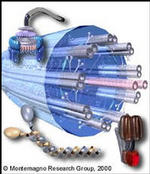 At this evenings meeting of the L.A. futurists group the speaker was Dr. Carlo Montemagno who runs the Department of Bioengineering and Biomedical Engineering at UCLA. He is a pioneer in hybrid biotech. Nanoscale Biological Engineering. Very impressive. Instead of trying to build little machines one atom at a time, which are very unstable, the idea is to do it more like nature's way. Get the right kind of proteins together under conditions where they'll follow simple rules consistently and do useful things. The 'hybrid' approach is doing nanotech with biological components. They're making good progress with something sort of like remote controlled slime molds. See this site. At this evenings meeting of the L.A. futurists group the speaker was Dr. Carlo Montemagno who runs the Department of Bioengineering and Biomedical Engineering at UCLA. He is a pioneer in hybrid biotech. Nanoscale Biological Engineering. Very impressive. Instead of trying to build little machines one atom at a time, which are very unstable, the idea is to do it more like nature's way. Get the right kind of proteins together under conditions where they'll follow simple rules consistently and do useful things. The 'hybrid' approach is doing nanotech with biological components. They're making good progress with something sort of like remote controlled slime molds. See this site.
[ Science | 2003-04-11 23:59 | 0 comments | PermaLink ]
|
|
| Tuesday, March 11, 2003 |  |
|
|
|
New scientific data is apparently indicating that the universe might finite and shaped like a doughnut, says a New York Times article. If you remember old computer games like Spacewar or Asteroids where, if one moves off the screen in one side, you come back from the other side. That's what would happen if the universe is finite and curved in one or more dimensions. And topologists would argue that finite spaces are more simple and easy to create than infinite spaces, so they're more likely shapes for the universe.The simplest of these compact universes is something called a 3-torus, a doughnut wrapped in three different dimensions. This object is essentially impossible to visualize: it is the equivalent, in a way, of a cube whose opposite sides are somehow glued together. In two dimensions it works just like the Spacewar screen.
Living in such a universe would be like being inside a hall of mirrors, Dr. Tegmark said. Instead of seeing new stars deeper and deeper in space, you see the same things over and over again as light travels out one side of your cube and back in the other. The finite universe model would do away with some of the troublesome and depressing aspects of the prevalent Big Bang inflation theory, which seemed to expect that everything would end up being terribly far from everything. Which just doesn't seem right.
[ Science | 2003-03-11 23:59 | | PermaLink ] More >
|
|
| Sunday, February 16, 2003 |  |
|
|
|
Here's a wild story that might possibly shed some light on why the U.K. and Australia are so dogged in their support for the U.S. war plans, for no obvious good reason. Anti-gravity. Apparently both the U.K. and Australia are involved in a very hush-hush anti-gravity project with the U.S., and might have been promised that they can have the technology too, if they play nicely enough. Doesn't sound all crazy to me. There must be something of that magnitude at play, for those governments to risk everything, and go against the very stong opinions of their populations in backing a war that doesn't have a reason.
[ Science | 2003-02-16 23:10 | 0 comments | PermaLink ]
|
|
| Friday, November 29, 2002 |  |
|
|
|
New Scientist reports some progress in quantum computing. In short, as opposed to normal computers that use bits that can be either on or off, quantum computing uses 'qubits' that can be in several states at once. That opens the door to the rather magical possibility of finding all solutions to a given problem at the same time. Practical applications appear to be far off. The current progress concerned the ability to keep one atom away from interferance, while still being able to read what state it is in.
[ Science | 2002-11-29 17:05 | | PermaLink ] More >
|
|
| Tuesday, November 26, 2002 |  |
|
|
|
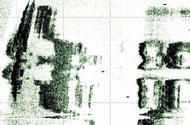 More about the possible man-made structures seen on sonar 2000ft underwater off the west coast of Cuba. Still nobody has gotten around to sending a submarine down there to take real pictures, so there is much speculation. The most controversial aspect is that the water depth would indicate that the structures would be at least 50,000 years old. More about the possible man-made structures seen on sonar 2000ft underwater off the west coast of Cuba. Still nobody has gotten around to sending a submarine down there to take real pictures, so there is much speculation. The most controversial aspect is that the water depth would indicate that the structures would be at least 50,000 years old.
[ Science | 2002-11-26 04:40 | 0 comments | PermaLink ]
|
|
| Thursday, November 21, 2002 |  |
|
|
|
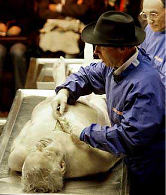 Public autopsy held in London. The controversial German doctor Gunther von Hagens, who previously caught some criticism for his anatomical exhibition Body Worlds, carried out the first public autopsy in many years, despite threats that he would be arrested. I applaud what he's trying to accomplish. I think it is very useful to show people how the human body works, in a dynamic and educational manner, and to get over our revulsion. Incidentally, I attended a couple of autopsies once. It was very educational, but didn't exactly strengthen my respect for modern medicine. I had imagined it to be a very precise science, sort of like clockwork repair. But it reminded me a whole lot more of a butchershop. I'll spare you the details here. Public autopsy held in London. The controversial German doctor Gunther von Hagens, who previously caught some criticism for his anatomical exhibition Body Worlds, carried out the first public autopsy in many years, despite threats that he would be arrested. I applaud what he's trying to accomplish. I think it is very useful to show people how the human body works, in a dynamic and educational manner, and to get over our revulsion. Incidentally, I attended a couple of autopsies once. It was very educational, but didn't exactly strengthen my respect for modern medicine. I had imagined it to be a very precise science, sort of like clockwork repair. But it reminded me a whole lot more of a butchershop. I'll spare you the details here.
[ Science | 2002-11-21 17:09 | | PermaLink ] More >
|
|
| Wednesday, November 20, 2002 |  |
|
|
|
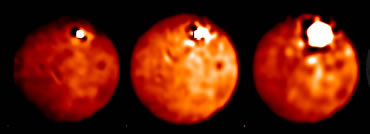
This is a volcanic erruption on Jupiter's moon Io, spewing lava several kilometers into the sky. Apparently the biggest ever erruption recorded in our solar system. I don't know why it is news now, because it seems like it was last year.
[ Science | 2002-11-20 23:59 | | PermaLink ] More >
|
|
| Friday, November 15, 2002 |  |
|
|
|
 Two Australian scientists believe they've found signs of a parallel mirror universe, by studying craters on the asteroid Eros. Apparently the only available explanation for the layout of the craters is that they've been splattered by mirror-matter. The Near-Shoemaker spaceprobe touched down on Eros briefly in 2000. Two Australian scientists believe they've found signs of a parallel mirror universe, by studying craters on the asteroid Eros. Apparently the only available explanation for the layout of the craters is that they've been splattered by mirror-matter. The Near-Shoemaker spaceprobe touched down on Eros briefly in 2000.
[ Science | 2002-11-15 23:59 | | PermaLink ] More >
|
|
<< Newer stories Page: 1 2 3 4 |

